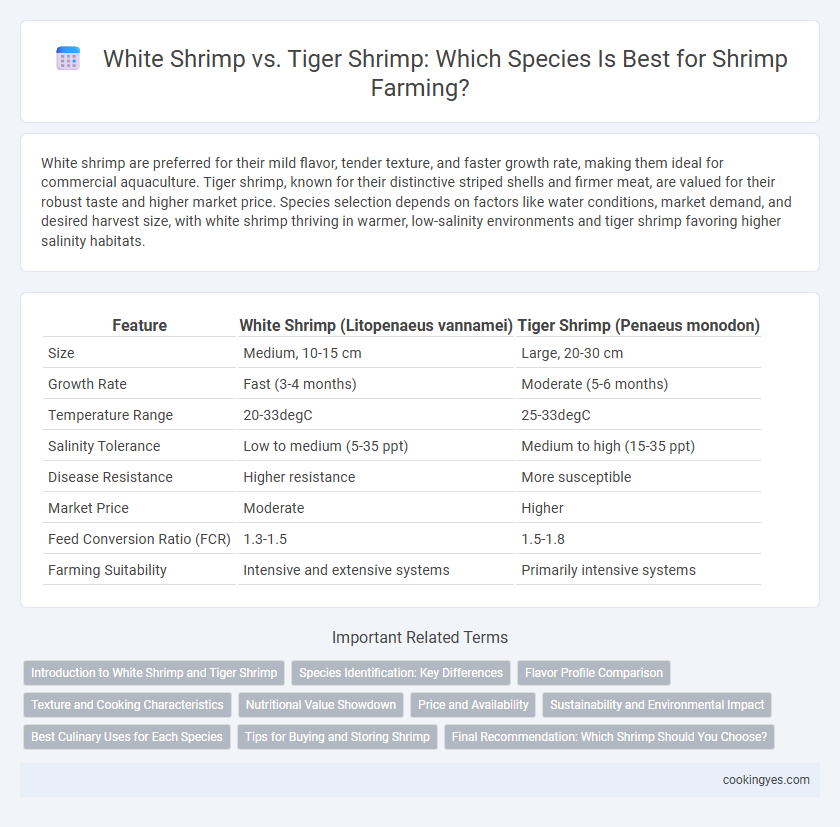White shrimp are preferred for their mild flavor, tender texture, and faster growth rate, making them ideal for commercial aquaculture. Tiger shrimp, known for their distinctive striped shells and firmer meat, are valued for their robust taste and higher market price. Species selection depends on factors like water conditions, market demand, and desired harvest size, with white shrimp thriving in warmer, low-salinity environments and tiger shrimp favoring higher salinity habitats.
Table of Comparison
| Feature | White Shrimp (Litopenaeus vannamei) | Tiger Shrimp (Penaeus monodon) |
|---|---|---|
| Size | Medium, 10-15 cm | Large, 20-30 cm |
| Growth Rate | Fast (3-4 months) | Moderate (5-6 months) |
| Temperature Range | 20-33degC | 25-33degC |
| Salinity Tolerance | Low to medium (5-35 ppt) | Medium to high (15-35 ppt) |
| Disease Resistance | Higher resistance | More susceptible |
| Market Price | Moderate | Higher |
| Feed Conversion Ratio (FCR) | 1.3-1.5 | 1.5-1.8 |
| Farming Suitability | Intensive and extensive systems | Primarily intensive systems |
Introduction to White Shrimp and Tiger Shrimp
White shrimp (Litopenaeus vannamei) are favored in aquaculture for their fast growth rate and adaptability to various salinity levels, making them ideal for intensive farming systems. Tiger shrimp (Penaeus monodon) are recognized for their larger size and superior flavor but require more specific environmental conditions, including higher salinity and temperature ranges. Choosing between these species depends on factors like local climate, farming infrastructure, and market demand for shrimp size and taste profiles.
Species Identification: Key Differences
White shrimp (Litopenaeus setiferus) are characterized by their translucent white to grayish body with a slightly curved rostrum and five to nine dorsal spines, while tiger shrimp (Penaeus monodon) display distinctive dark vertical stripes across their shell and a more pronounced, serrated rostrum. White shrimp typically grow to smaller sizes, averaging 15-20 cm, and prefer estuarine and nearshore environments, whereas tiger shrimp can reach up to 33 cm and thrive in warmer, tropical waters. Morphological distinctions such as rostrum length, body coloration, and size are essential for accurate species identification in aquaculture and fisheries management.
Flavor Profile Comparison
White shrimp (Litopenaeus vannamei) offers a mild, sweet flavor with a tender texture, making it ideal for delicate dishes and subtle seasoning. Tiger shrimp (Penaeus monodon) presents a firmer, meatier bite with a slightly briny taste, providing a robust flavor that holds up well to bold spices and grilling. Choosing between white and tiger shrimp depends on the desired taste intensity and culinary application, with white shrimp favored for subtlety and tiger shrimp for pronounced flavor.
Texture and Cooking Characteristics
White shrimp (Litopenaeus vannamei) features a tender, delicate texture ideal for quick cooking methods like sauteing and grilling, which preserves its subtle sweetness. Tiger shrimp (Penaeus monodon) has a firmer, meatier texture that holds up well to robust cooking styles such as frying and broiling, allowing it to absorb stronger flavors without becoming mushy. The choice between these species depends on preferred texture and cooking technique, with white shrimp suited for lighter dishes and tiger shrimp favored in hearty, flavorful recipes.
Nutritional Value Showdown
White shrimp (Litopenaeus vannamei) offers a lean protein source with lower fat content and ample levels of omega-3 fatty acids, vitamins B12 and D, and minerals like selenium. Tiger shrimp (Penaeus monodon) provides a richer nutritional profile, higher in zinc, iron, and antioxidants such as astaxanthin, contributing to immune health and reducing inflammation. Choosing between white shrimp and tiger shrimp depends on desired nutrient emphasis, whether prioritizing heart-healthy fats or mineral-rich benefits.
Price and Availability
White shrimp (Litopenaeus vannamei) generally command a lower price than tiger shrimp (Penaeus monodon) due to their faster growth rates and higher availability in global markets. White shrimp dominate aquaculture production, especially in the Americas and Asia, making them more accessible and cost-effective for large-scale farming. Tiger shrimp, prized for their size and texture, tend to be more expensive and less readily available outside specific regions like Southeast Asia.
Sustainability and Environmental Impact
White shrimp (Litopenaeus vannamei) are favored for sustainable aquaculture due to their fast growth rates and lower environmental footprint compared to tiger shrimp (Penaeus monodon), which require more extensive resources and are prone to habitat disturbance. White shrimp farming often employs recirculating aquaculture systems that minimize water use and effluent release, enhancing ecosystem protection. Tiger shrimp cultivation, while economically valuable, poses higher risks of mangrove deforestation and disease outbreaks, challenging long-term sustainability goals.
Best Culinary Uses for Each Species
White shrimp (Litopenaeus vannamei) feature a tender texture and mild, sweet flavor that excels in delicate dishes such as ceviche, shrimp cocktails, and light sauteed recipes, making them ideal for raw or lightly cooked preparations. Tiger shrimp (Penaeus monodon) offer a firmer texture and more pronounced, briny taste that holds up well to bold seasonings and grilling, ideal for robust dishes like shrimp scampi, spicy stir-fries, or barbecued shrimp. Selecting white shrimp is optimal for subtle-flavored cuisine emphasizing natural sweetness, while tiger shrimp suit recipes requiring a meatier bite and stronger shrimp presence.
Tips for Buying and Storing Shrimp
Choose white shrimp for a milder, sweeter flavor and tiger shrimp when seeking a firmer texture and bolder taste. Always buy shrimp that are translucent with a mild sea scent, avoiding those with black spots or a strong ammonia odor to ensure freshness. Store shrimp in the coldest part of the refrigerator in a covered container or on ice, and use within two days for optimal quality.
Final Recommendation: Which Shrimp Should You Choose?
White shrimp (Litopenaeus vannamei) offer faster growth rates and better disease resistance, making them ideal for commercial aquaculture. Tiger shrimp (Penaeus monodon) provide larger size and higher market value but require more intensive management and are susceptible to diseases like white spot syndrome. Choose white shrimp for ease of farming and consistent yield; opt for tiger shrimp if prioritizing size and premium price despite increased risks.
White shrimp vs tiger shrimp for species selection Infographic

 cookingyes.com
cookingyes.com